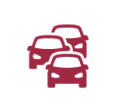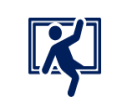What Is Defensive Driving?
5 Tips for Defensive Driving
Never Assume

Never assume other drivers are driving:
Watch out for drivers that are:
- Swerving and/or speeding.
- Disrespecting the rules of the road.
Watch Out

Scan the road ahead and use your mirrors to get an idea of what's going on around you.
See brake lights ahead or a vehicle approaching rapidly? Defensive drivers practice awareness to keep themselves safe.
3-4 Second Rule

Make sure you have plenty of time to react. Give the car ahead of you a 3 to 4 second following distance.
If you pass a landmark less than 3 seconds after the car in front of you, slow down! It's dangerous and nobody likes a tailgater.
Have an Escape Plan

Always have a way to extract yourself from a bad situation, whether by switching lanes or braking.
Stay visible to other drivers. Use your headlight, maintain a reasonable speed, and avoid blind spots.
Expect the Unexpected

Stay alert and focus on the road. By expecting the unexpected you can anticipate the actions of other drivers and respond appropriately.
Defensive driving is when drivers actively scan, anticipate movements, and prepare to respond quickly to potential hazards on the road. Besides prioritizing your safety, defensive driving also helps you avoid potential accidents. Expecting other drivers to make mistakes and being prepared to react accordingly is not only common sense, it can also save lives. Defensive driving is important because this sort of preventative real-time analysis allows you to both quickly respond to dangerous drivers and stay out of risky situations.
Plan for the Unexpected
Even if you’re following all the rules of the road, conditions on the road can lead to surprises that put you and your passengers at risk. Here are some things defensive drivers should watch out for:
- Brake lights. The minivan in front of you may be cruising along without incident, but a sea of red lights from other cars means it’s time to slow down. Abrupt braking not only puts you at risk – it puts everyone behind you in danger as well. Scanning your surroundings beyond the car in front of you is always a good idea.
- Cars behind you. A car blasting past you in the right lane can be disorienting and interrupt your focus at high speeds. Keeping an eye on the cars behind you can reduce surprises and keep you apprised of the situation on the road.
- In-Car Chaos. The inside of your car can be a road hazard in its way. Do your best to minimize distractions in your vehicle and be on the lookout for other drivers who might be struggling to stay focused.
Follow the 3-4 Second Rule
Nobody likes a tailgater; it’s rude and dangerous. Give the car in front of you plenty of space to maneuver by maintaining a 3-4 second following distance. Choose a feature along the road such as a streetlight or a mile marker and start counting once the car in front of you passes it. If you pass the same point less than 3 seconds later, you’re too close. For every negative road condition (rain, fog, construction, etc.) add an extra second.
Don’t Depend on Other Drivers
You can’t control the actions of other drivers, but you are in charge of your car. Here are some defensive driving tips to keep you and your passengers safe:
- Never assume. Just because you are sober, awake, and know the rules of the road doesn’t mean everyone else does. Even other competent drivers can be a threat if they’re lost or dealing with their distractions. Give everyone room on the road, especially if they’re acting strangely.
- Stay focused. Music, kids, friends, phones, snacks, and high emotions can all divert your attention away from the road. Cut out distractions and reduce your risk of being in an accident.
- Watch intersections. Whether someone is trying to get across four lanes to take a left or not paying attention to the neighborhood stop sign, you need to be alert. Keep an eye out for cars that are either confused by or disrespectful of the rules.
Have an Escape Route
One of the last places you want to be is sandwiched between two trucks with a tailgater when someone brakes abruptly in front of you. Defensive drivers should always leave room to maneuver while on the road. Another element to escape routes is making sure your car is visible to other drivers. Stay out of blind spots and keep your headlights on when appropriate.
Contact Us
Keep your family and your pocketbook safe with defensive driving. Whether you’re a new driver or have been behind the wheel for decades, United Auto Insurance has the car insurance policy for you. Contact us today for a free quote.